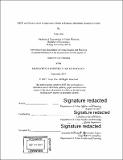| dc.contributor.advisor | David Geltner. | en_US |
| dc.contributor.author | Zou, Linyi | en_US |
| dc.contributor.other | Massachusetts Institute of Technology. Department of Urban Studies and Planning. | en_US |
| dc.coverage.spatial | a-cc--- | en_US |
| dc.date.accessioned | 2018-02-16T20:06:30Z | |
| dc.date.available | 2018-02-16T20:06:30Z | |
| dc.date.copyright | 2017 | en_US |
| dc.date.issued | 2017 | en_US |
| dc.identifier.uri | http://hdl.handle.net/1721.1/113804 | |
| dc.description | Thesis: M.C.P., Massachusetts Institute of Technology, Department of Urban Studies and Planning, 2017. | en_US |
| dc.description | Page 77 blank. Cataloged from PDF version of thesis. | en_US |
| dc.description | Includes bibliographical references (pages 71-76). | en_US |
| dc.description.abstract | Affordable housing finance in China is a hot issue, which mainly relies on government budgets and bank loans. These two financing channels are insufficient to support the large number of affordable housing projects, and there is a need to explore innovative channels. Within them, this thesis focuses on REITs and other types of securitization (ABN and ABS), in order to research their implementations in affordable housing finance, as well as the obstacles and impacts. In 2005, Hong Kong Government created the first REIT by privatizing and securitizing the retail and parking facilities affiliated to affordable housing owned by the government. This REIT was financially successful with good stock performance; nonetheless, as an equity REIT, its underlying assets were fully owned by private REIT manager with profit-oriented strategy, which undermined its affordability and caused negative social impacts. Four years later, mainland China wanted to learn from Hong Kong and create the first REIT by securitizing the affordable housing properties in Tianjin Municipality. However, this practice was unsuccessful, due to a lack of REITs legislation in mainland China and a tightening of government regulations on the overheated real estate market. It turned out this pilot project of REIT had to be restructured in 2012 as ABN, an existing financial instrument that could be issued quickly. In 2014, mainland China began a new experiment of using ABS to securitize and finance affordable housing projects in Xuzhou City. Compared with ABN, the ABS business was more advanced and similar to REITs in terms of structures, thus mainland China has taken one step closer to REITs. This thesis predicts that mainland China will establish its REITs legislation in the near future, which might be based on and modified from the ABS regulations, due to their similarities. Besides, future REITs could be implemented in affordable housing through debt financing instead of equity financing: on one hand, affordable housing projects have low return (below-market rent) and low risk (government guarantee), which are suitable for debt financing; on the other hand, the government could keep ownership of affordable housing in order to ensure its affordability. | en_US |
| dc.description.statementofresponsibility | by Linyi Zou. | en_US |
| dc.format.extent | 83 pages | en_US |
| dc.language.iso | eng | en_US |
| dc.publisher | Massachusetts Institute of Technology | en_US |
| dc.rights | MIT theses are protected by copyright. They may be viewed, downloaded, or printed from this source but further reproduction or distribution in any format is prohibited without written permission. | en_US |
| dc.rights.uri | http://dspace.mit.edu/handle/1721.1/7582 | en_US |
| dc.subject | Urban Studies and Planning. | en_US |
| dc.title | REITs and securitization as innovative modes to finance affordable housing in China | en_US |
| dc.title.alternative | Real Estate Investment Trusts and securitization as innovative modes to finance affordable housing in China | en_US |
| dc.type | Thesis | en_US |
| dc.description.degree | M.C.P. | en_US |
| dc.contributor.department | Massachusetts Institute of Technology. Department of Urban Studies and Planning | |
| dc.identifier.oclc | 1022949024 | en_US |
